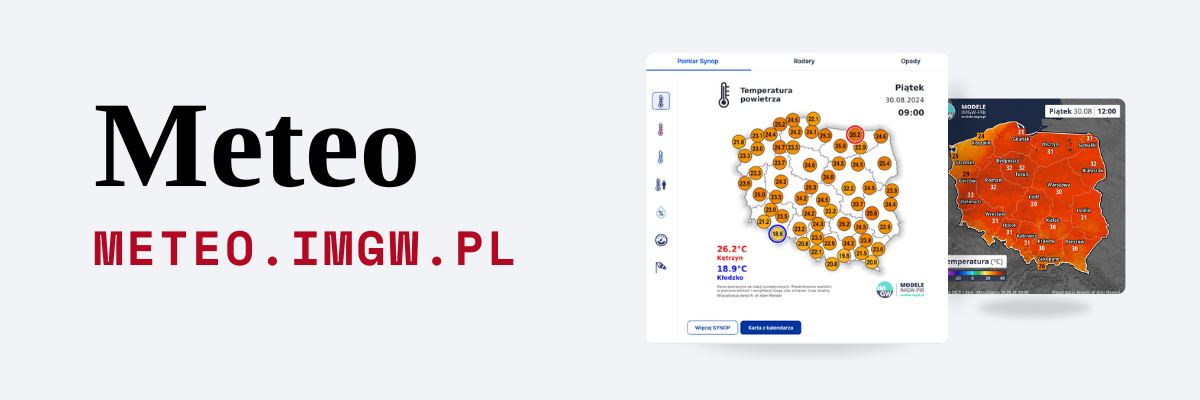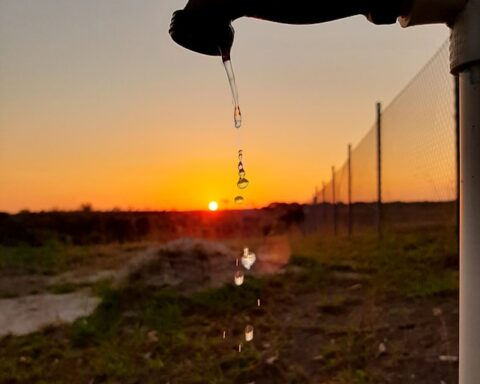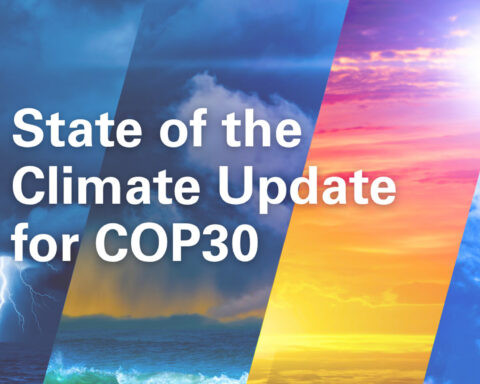The hydrological year is the contractual period, beginning on 1 November and lasting until 31 October, which serves as the basis for calculating the country’s water balance. It is assumed that the turn of October and November is usually the end of rainwater run-off from summer-autumn heavy rainfall and storms, and thus the beginning of the autumn-winter period when the decrease in temperature favours the development of ice phenomena and the probability of snowfall increases. The definition is, of course, a kind of compromise to which there are exceptions, e.g. in mountainous areas, snowfall may start earlier, before 1 November, and rainwater run-off may still occur in October.
We started the hydrological year 2022 with a stabilised situation on the rivers. After the high summer rainfall, there was little rain in October and November, which resulted in decreasing water stages and slight fluctuations. This trend continued in December, with other factors affecting the hydrological situation in the second half of the month, namely low temperatures, which allowed ice phenomena to develop, affecting the local water levels. In the last days of December, there was a definite warming and heavy rainfall. The melting snow cover formed flood waves on the Vistula River and Oder River in the first days of January, which were below the contractual levels. Both January and February were quite wet months. Precipitation caused frequent increases in fluctuating water stages but without any greater risks. The winter of 2021/2022 was not rich in well-developed ice phenomena, and their impact on the hydrological situation was minor. As in previous years, a more significant hazard was the increase in water levels at marine stations and those under the influence of the Baltic Sea, caused by a large number of days with strong winds from the northern sector. Exceedances of warning and alarm levels were recorded in many places.
Drought in spring
After a rather cold and wet winter season (January and February), March brought a significant rainfall deficit, and it was then that we could talk about the first signs of recurring hydrological drought. The danger increased in April and May due to low rainfall and higher air temperatures, favouring increased evaporation.
At the beginning of March, medium and high water zones prevailed at water gauge stations in Poland, and only a locally low water zone was observed. Locally, exceedances of contractual levels also persisted. It was the result of supplying rivers with water from melting snow cover (in the northeast of the country and in the mountains) and rainfall, which occurred regularly in winter and over a large area of Poland. The situation changed dramatically in March due to a precipitation deficit, and such a state persisted in April, despite a snow episode at the beginning of the month.

Summer flash floods
The beginning of summer was different. High air temperatures contributed to earlier vegetation, and there was no significant convective precipitation, which usually occurs in May. Such conditions translated into an increased risk of drought in June. The situation was aggravated by heat waves, during which 38.3°C was recorded in Słubice on 19 June. At the beginning of the month, the water stages of the main rivers in Poland dropped to the medium and low water zone. The high zone was only very locally present. Despite several thunderstorm episodes and heavy rainfall, increases were only noted in the Vistula basin, including the Brynica River, where the alarm level was exceeded. The water stage on the Oder continued to fall to the low water zone.
July was marked by deepening hydrological low water but also by flash floods. The first was recorded on 1 July in Szczecin and the last on 30 July in Częstochowa, where as much as 68.9 mm of rain fell in 24 hours, a record for June 2022. The hydrological low water was progressing in the Oder basin, and more significant increases and fluctuations of water stages were observed only in the catchment area of the upper Vistula.
August was one of the most dynamic months of the hydrological year 2022. The first half of the month was record dry, despite the storm episodes and local floods. On 19 August, 248 stations recorded a flow lower than the SNQ, which was the worst drought situation since 2015. An unexpected improvement came on the following days, during which precipitation was primarily continuous. In Opole, 273.0 mm of rain fell during the month, over 500% of the precipitation normal, with more than 100 mm falling in just 24 h. Unfortunately, such intense rainfall caused flooding and inundation of buildings and urban infrastructure.
September was recorded as a cold month, below the thermal normal. Occurring rainfall began to rebuild water resources severely strained by the dry spring and summer. However, there was no local flooding. One of the last flash floods of the season occurred on 7 September in Gorzów Wielkopolski, where 130.4 mm fell in 24 hours. September was also an unusual month due to the hydrological drought. A significant improvement in water relations was observed in the Odra basin, which cannot be said of the Vistula basin, where drought occurred in Podkarpacie and Mazovia.

Warm period of winter dormancy of plants
Late autumn and winter is a time of plant dormancy. However, the meteorological conditions prevailing during this period are essential for the overwintering of plants and the condition they will be in the spring. The first months of the hydrological year 2022 turned out to be warmer than the long-term average of 1991-2020. In particular, January 2022 was thermally warm, and February was even very warm over most of the country. The thermal situation changed in March. The average monthly temperatures over most of the country were within the normal, and only partially in Lubuskie and Wielkopolskie voivodeships this month was moderately warm.
In terms of precipitation, the winter dormancy period of plants was exceptionally varied – November and January were, on average wet, December was dry, and February was very wet (on average in Poland, almost 160% of the precipitation normal was recorded then). In turn, March was an extremely dry month in most areas of the country. At many stations in northern and central Poland, no day with precipitation was recorded then, and only 1-2 days at a number of others. At almost half of the synoptic stations, precipitation totals in March this year were the lowest since 1966, which is an absolutely exceptional situation.
The temporal and spatial distribution of precipitation significantly influenced the values of the soil moisture index. In January and February, relatively high, in some places, even too high humidity was observed, especially in the surface layer. Excessive water was observed in cultivated fields, which posed a risk to winter crops that are exposed to soaking under such conditions, i.e., losses because of flooding the plants and cutting them off from necessary oxygen, and they are also more susceptible to diseases. In January, freezing of the surface layer of the soil was additionally observed as a result of a several-day but significant decrease in air temperatures. While, in March, due to the lack of precipitation, high sunshine duration, and strong wind at times, the moisture index in the surface soil layer began to decrease rapidly. In large areas, especially in western Poland, the moisture index dropped to around 30%, indicating soil drought. Such conditions were very unfavourable for nitrogen fertilisers sown in winter crops, preventing their dissolution and fertiliser use by the plants. The winter crops also observed symptoms of phosphorus deficiency due to progressive soil drought and relatively low temperatures. The drying soil caused problems in the development of seedlings of winter wheat sown very late. Due to unfavorable moisture conditions, the sowing of spring cereals was also delayed in many places.
Development of drought during the growing season
April, which in Poland is considered the first month of the growing season, was extremely cold in terms of temperature and average in terms of precipitation. For this reason, the moisture index in the surface layer of the soil began to increase rapidly and by the end of the first decade of this month was around 50-60% in most of the country, and in south-eastern Poland, even 80-90%. April rainfall was primarily sufficient to meet the water needs of cultivated plants. Deficiencies affected only winter rape and spring wheat in the northern part of the country. Beet sowing continued throughout April, and plant emergence was favoured by rainfall during the month.
May, thermally similar to the long-term average, was dry and very dry in most parts of the country in terms of precipitation and locally extremely dry in southern Poland. The shortage of precipitation did not fully satisfy the water needs of most cultivated plants. The lack of precipitation during the flowering period of rapeseed was manifested by a reduction of siliques. The decrease in the effectiveness of herbicides due to the drought was also a significant problem. From the first days of May, the humidity deteriorated. At the end of the second decade of the month, in the surface layer (0-7 cm) and shallow root layer (7-28 cm), soil drought covered almost the entire country (except for foothill areas). Increasing evaporation losses added to the deepening shortage of rainfall. The lack of precipitation was reflected in the values of the climatic water balance, which shows the difference between the inflow of moisture (precipitation) and its ouflow (evaporation). The totals of the climatic water balance in May were negative in most of the country. The lowest totals were recorded in Wielkopolskie, Lubuskie, and the northern part of Lower Silesia voivodeships.
June was extremely warm thermally but very variable in terms of precipitation. The lowest rainfall was recorded in the Lubelskie and Podkarpackie voivodeships and large areas of the Zachodniopomorskie voivodeship, which was very dry there. At the same time, precipitation was within the normal or significantly exceeding it in some areas. It was very wet, especially in north-eastern Poland and locally in Silesia. However, it should be noted that a significant part of this precipitation came from quite frequent in this month, local, strong showers accompanied by thunderstorms. Although the soil moisture index improved, the shortage of precipitation in relation to the demand for water for the crops influenced the inadequate satisfaction of the water needs of many cultivated plants, and the climatic water balance values in June were negative in almost the entire country. At the end of the second decade of June, the 'small harvest’ began. Barley was harvested first. Such an exceptionally early harvest date was influenced, among others, by the earlier drought in May, which accelerated the maturation of the grains.

Harvest season
In terms of temperature and precipitation, July was average in most parts of the country, although the spatial distribution of precipitation varied strongly. The least rain fell again in the western and north-western voivodeships. The significant precipitation deficit in western Poland worsened soil moisture conditions in the shallower and deeper root layer. The weather conditions, especially the uneven rainfall distribution, contributed to the extension of the harvest time this year, and the drought, which mainly affected the country’s western regions, caused an increase in the fire danger of wasteland and agricultural crops.
August was extremely warm in most of the country. The average air temperature for Poland exceeded the long-term average by as much as 2.4oC. On the other hand, some areas’ totals of climatic water balance were close to zero or had high positive values. It was the result of locally high and extremely high precipitation. In August, the cereal harvest ended, and the weather in this month had no influence on the condition of the cereal plants but only on the course of field work, which was mostly carried out as planned. However, weather conditions, particularly the uneven rainfall distribution, contributed to yield losses of maize, root crops, and permanent grassland and affected the sowing of winter rape. The situation was worst for maize – in the drought-affected regions, the overall condition of this crop worsened, especially on lighter soils, manifesting itself, among others, as wilting of leaves and even their drying out. Significant rainwater shortages in August also affected meadows and pastures, particularly in eastern and western Poland.
End of the growing season
In terms of temperature, September was cold in most of the country and even extremely cold in places. In terms of precipitation, September was average. In the second half of the month, the silage maize harvest began, and the grain maize harvest was in the west of the country. Rainfall in the second and third decade of September further delayed the harvest (especially in the south and east of the country), e.g., due to high grain moisture. Delays were also observed locally in the sowing of winter crops, among others, due to rainy weather in the south and southeast. At the end of the month, the sugar campaign and the potato harvest also started. They lasted throughout October, helped by exceptionally warm and not too rainy weather.
Despite the dangerous hydrological phenomena associated with the progressing drought on the one hand and local flooding on the other, the last hydrological year can be considered relatively calm. The following months were quite highly variable in terms of weather conditions, which particularly affected the plant cultivation conditions, but also field work. Variable precipitation conditions caused significant fluctuations in soil moisture. This is clearly visible in the presented chart of the soil moisture index in individual layers for the Wielkopolskie voivodeship, which in the previous hydrological year struggled with periodic shortages of precipitation and, consequently, with agricultural drought.
Main photo: Mykyta Martynenko | Unsplash.




















